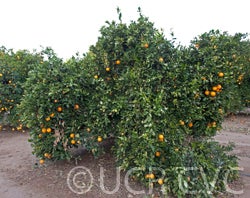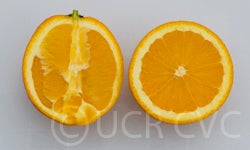Citrus sinensis (L.) Osbeck
CRC 3732
PI 539575
VI 338
Source
Received as budwood from another location on the University Field Station, 1967.
Parentage/origins
Budwood taken from a limb with a 38-fruit cluster.
Rootstocks of accession
Carrizo citrange
Season of ripeness at Riverside
December to January
Notes and observations
EMN, 3/23/1987: This accession was heat-treated prior to processing as VI 338 for moving to Lindcove. Some fruit on ground but most still on tree while most other navels are on the ground at this time. Paul Moore thinks this budline may be the only reliable navel for the smog belt despite many small size and off-bloom fruit, and he may be right.
EMN, 11/10/1987: Quizzed Paul Moore re: history of Cluster. He says this was a limb sport he found in an old budline Washington navel tree in an old orchard the University acquired when the campus expanded. His first propagations were from buds from pedicels behind fruit; later propagations were with normal budwood.
EMN, 2/12/1988: Cluster is inherently weak growing and has a tendency toward branch & limb dieback. One variety collection tree has died and the other has had many branches die. Remaining live branches have a heavy crop of fruit which are of small size on average but with some normal sized navel fruit; also this accession sets many off-bloom fruit.
EMN, 11/1988: Both trees at 12B-7-5,6 are now dead. Will be replaced in same locations with new trees on Carrizo in spring 1989. If these die, could try another rootstock next time around.
Availability
Commercially available in California through the Citrus Clonal Protection Program. Click here to order budwood.
USDA Germplasm Resources Information Network page for Cluster navel orange



